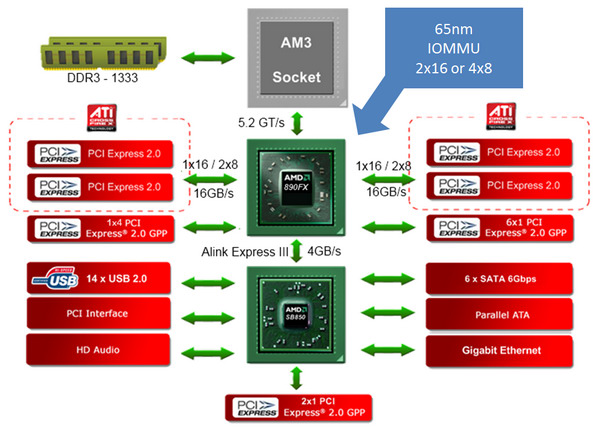Gigabyte GA-890FXA-UD7 Motherboard
|
Much time has passed since the rollout of AMD 790FX, the previous flagship chipset. Not only the CPU lineup, but also the platform in general has changed since that time. Such a long life cycle may even seem surprising for a top-end product -- enthusiasts are quite demanding to the availability of latest technologies. But even now it's hard to think of anything useful the 790FX Northbridge lacks. This chip is responsible for PCI Express support. In due time it was the first to offer support for PCI Express 2.0 across all lanes (while Intel and NVIDIA chipsets only supported the 2nd version on graphics lanes. As for the number of PCIe lanes, it's enough to build a CrossFire configuration with two top-end graphics cards that may theoretically require the x16+x16 mode.
Still, the rollout of AMD 890FX was completely foreseeable. The new chipset is not just the renamed 790FX, though the differences between the two are minor. Let's take a look at the flowchart.
890FX + SB850 specifications are below.
- Support for all Socket AM3 CPUs (Phenom II, Athlon II, Sempron 140);
- Up to 4 x PCIe x16 slots (PCIe 2.0) ports, x16+x16, x16+x8+x8, x8+x8+x8+x8 CrossFire modes;
- Up to 8 PCIe x1 slots (PCIe 2.0), 6 Northbridge-based, 2 Southbridge-based;
- 6 x SATA 6Gbps ports for 6 devices, support for AHCI, NCQ, eSATA, support for RAID 0, 1, 0+1 (10), 5;
- Up to 4 x PCI slots;
- 14 x USB 2.0 ports based on two EHCI host controllers;
- Gigabit Ethernet MAC controller;
- 7.1-channel High Definition Audio;
- 1 PATA port for 2 PATA/133 devices;
- Support for legacy peripherals.
So, compared with 790FX + SB750, the new chipset has SATA 6Gbps support and a twice as fast chipset bus. The latter should also speed up the aforementioned SATA controller, when multiple drives are connected. Another difference is a Gigabit Ethernet controller, but it's mostly valuable for inexpensive motherboards, because the difference in controller cost prices is insignificant.
A new chipset rollout, much different or not, always stimulates motherboard makers to freshen up product lines. Note that AMD doesn't force compatibility limitations. If you need a new motherboard, you may also consider one of the newest models. But if you already have a decent Socket AM2+/AM3 motherboard, you can upgrade its firmware and still use a hexacore CPU.
Design
If motherboard makers contrive to install three graphics slots on motherboards that normally support only two, then how many graphics slots should you expect from a motherboard that normally supports four? Right you are, at least six. Or rather exactly six, because at least one PCI slot is still needed for your otherwise working TV tuner, sound card or whatnot. On the other hand, such motherboards are primarily intended for people who are ready to spend a lot on their PCs. Otherwise some expansion capabilities will be unused, meaning that buying a lower-class motherboard will be more reasonable.
The two additional PCIe x16 slots use chipset's additional lanes and may be configured flexibly from BIOS, the number of lanes ranging from 1 to 4. Of course, all motherboard's PCIe slots can also work with cards other than graphics.
Gigabyte GA-890FXA-UD7 supports six SATA 6Gbps ports. But if you plan on using an SSD drive that may require controller's full capacity, there are two SATA 3Gbps ports for regular drives provided by an auxillary chip.
The motherboard is as full-fledged as any top-class solution can be. It's really hard to think of any useful features it lacks. There are two Gigabit Ethernet ports, both kinds of FireWire ports, both kinds of S/PDIF outputs. Also provided are two eSATA/USB combo ports (3Gbps though, based on an auxillary controller). Finally, there are two USB 3.0 ports marked blue.
Write a comment below. No registration needed!
|
|
 |
|
|
|



